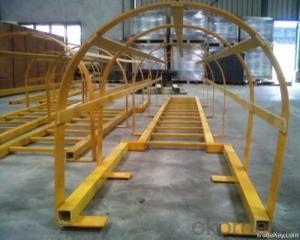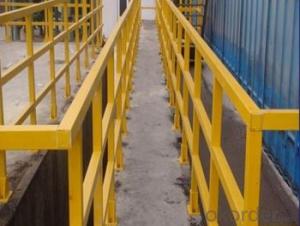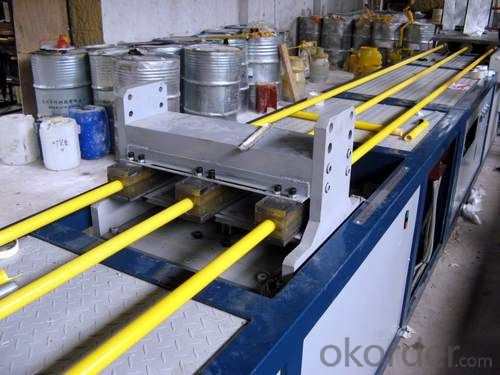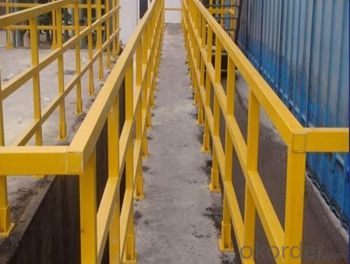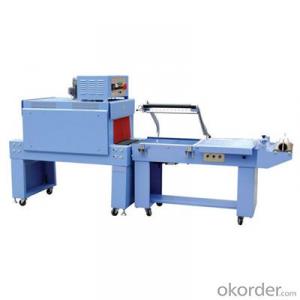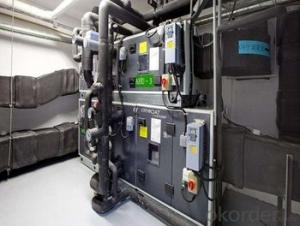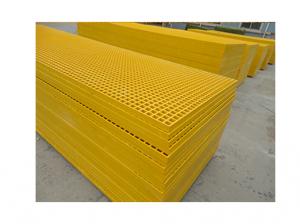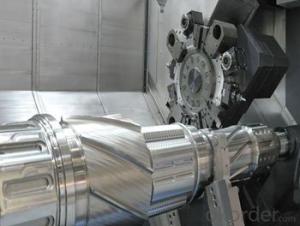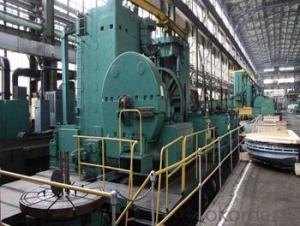Corrosion resistant FRP Pultruded grating and Pultrusion Process on sales
- Loading Port:
- Tianjin
- Payment Terms:
- TT OR LC
- Min Order Qty:
- 20000 m.t.
- Supply Capability:
- 100000 m.t./month
OKorder Service Pledge
OKorder Financial Service
You Might Also Like
Specification
PRODUCT DESCRIPTION
Pultruded grating is made by a particular assembly process, which using “I” shape as its main load-bearing and special rod to go through the bearing bar. Pultruded grating include the standard grating and the custom grating, the custom grating can be designed to meet customer’s requirement or special using condition by changing the shape, size and space of the bearing bars, the surface can be covered with lozenge panel, grit panel, or added the anti-slippery sand directly.
FRP pultruded grating has the most characteristics of molded grating, but it has its distinct advantages, it has very high fiberglass content in the loading direction, so it has very high load capability, it has more superiority when used at wide span, so that the basic support will be decreased and the project cost will be reduced accordingly.
SPECIFICATION
The standard space between two crossbars is 6 inch or 12 inch.
Thickness (mm) | Bar width (mm) | Open space (mm) | Open rate (%) | Approx weight (kg/m |
25.4 | 15.2 | 22.8 | 60 | 13.2 |
25.4 | 15.2 | 15.2 | 50 | 15.9 |
25.4 | 15.2 | 10.1 | 40 | 18.5 |
25.4 | 40 | 10.8 | 21 | 14.5 |
38.1 | 15.2 | 22.8 | 60 | 15.8 |
38.1 | 15.2 | 15.2 | 50 | 19.1 |
38.1 | 15.2 | 10.1 | 40 | 22.4 |
50.8 | 25.4 | 25.4 | 50 | 16.6 |
50.8 | 25.4 | 12.7 | 33 | 21.1 |
CHOICE FOR PULTRUDED GRATING
Resin: GP resin, ISO resin, VE resin, Phenolic resin
Color choice: Yellow, gray, green, custom color
Surface choice: Groove surface, grit surface, lozenge cover surface
FEATURES
a. Anti-corrosion and anti-rust
b. Light weight and high strength
c. Anti-flammable
d. Anti- fatigue
e. Safe and anti-slippery
f. Anti-ageing
g. Easy of maintenance
h. Excellent electromagnetism property
i. Good economic benefit
FIELDS SERVED
Sewage treatment,
water supply and drainage,
chemical industry,
oil industry,
power engineering,
pulp and paper,
construction engineering,
spinning, marine engineering.
APPLICATION
Operation terrace,
stair walkway,
ground floor,
trench cover,
sidewalk,
foot bridge,
equipment safety fence,
scaffold.
COMPANT DESCRIPTION
CNBM,China National Building Materials Group is a state-owned enterprise in charge of administrative affairs in china building materials industry. Established in 1984, CNBM is a large group corporation of building materials with total assets of 25 billion RMB and a total staff of 30,000.CNBM now owns 200 subordinating firms of solely owned and joint-venture companies.
CNBM International Corporation is one subsidiary of CNBM, we focus on offering good-quality products,professional service and complete solution to our customers. Strong delivery capacity, advanced technology& management, strong financing capability and excellent after-sale service are our advantages in sharing international market.
FAQ
1.Q:Are you factory or trading company ?
A:We are Factory produce FRP machines and FRP products.
2.Q:If can customized by customers requirements?
A:yes,we can produce the machine with customized size.
3.Q:How about the payment?
A:We accept any kind of payment.
4.Q:What is the guarantee?
A:Gurantee is one year.
5.Q:If you can training?
A:yes ,we can training in our factory also can send engineers to your factory training.
PICTURES
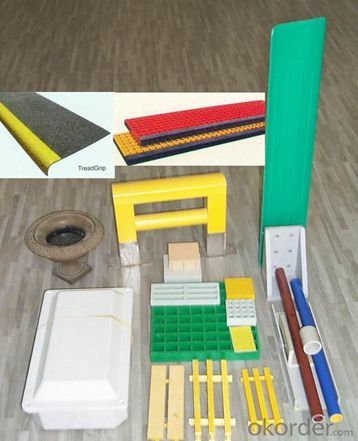
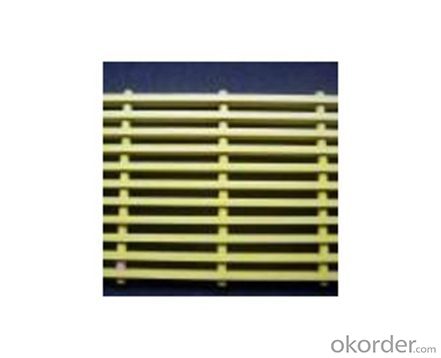
- Q: Can FRP pultrusion profiles be used in the automotive industry?
- Certainly, the automotive industry can certainly make use of FRP (Fiber Reinforced Plastic) pultrusion profiles. These profiles possess several advantages that render them appropriate for automotive purposes. To begin with, FRP pultrusion profiles are lightweight, a critical factor in the automotive industry as it contributes to better fuel efficiency and reduced vehicle weight. Vehicles that are lighter consume less energy and emit fewer pollutants, making them more eco-friendly. Moreover, FRP pultrusion profiles exhibit a remarkable strength-to-weight ratio, enabling them to provide high strength and stiffness while remaining lightweight. This characteristic makes them ideal for structural components in automobiles, such as chassis, body panels, and support structures. In addition, FRP pultrusion profiles display exceptional corrosion resistance, a considerable advantage in automotive applications. Vehicles are frequently exposed to harsh environmental conditions, including moisture, salt, and chemicals. The corrosion resistance of FRP ensures the durability and longevity of automotive components, even in challenging environments. Furthermore, FRP pultrusion profiles possess impressive impact resistance, a crucial aspect of automotive safety. They can effectively absorb and dissipate energy during impacts, reducing the risk of injury in the event of accidents. Moreover, FRP pultrusion profiles can be customized and engineered to meet specific design requirements, allowing for versatility in automotive applications. They can be tailored to possess specific mechanical properties, shapes, and sizes, making them suitable for various automotive components. Overall, the combination of lightweight construction, high strength, corrosion resistance, impact resistance, and customization options make FRP pultrusion profiles an excellent choice for the automotive industry. They offer numerous benefits, including improved fuel efficiency, enhanced safety, and extended component life, making them a viable alternative to traditional materials in automotive applications.
- Q: Can FRP pultrusion profiles be used in the construction of conveyor systems?
- Yes, FRP (Fiber Reinforced Polymer) pultrusion profiles can be effectively used in the construction of conveyor systems. FRP pultrusion profiles offer several advantages that make them suitable for such applications. Firstly, FRP pultrusion profiles are lightweight yet strong, making them ideal for conveyor system construction. Their high strength-to-weight ratio allows for easy installation and maintenance, reducing the overall weight of the system while maintaining structural integrity. This feature is particularly beneficial when designing and building long-span conveyor systems. Secondly, FRP pultrusion profiles are highly corrosion-resistant. Unlike traditional materials like steel or aluminum, FRP pultrusions are resistant to rust, chemicals, and moisture. This resistance makes them suitable for conveyor systems that may be exposed to harsh environments or corrosive substances, such as in mining or chemical industries. Another advantage of FRP pultrusion profiles is their electrical insulation properties. They do not conduct electricity, which is a crucial requirement in conveyor systems where electrical components are present. This property ensures a higher level of safety and reduces the risk of electrical hazards. Furthermore, FRP pultrusion profiles can be easily customized to meet specific design requirements. They can be manufactured in various shapes and sizes, allowing for flexibility in conveyor system design. Additionally, FRP profiles can incorporate features such as channels, slots, or reinforcements, which can be advantageous for mounting accessories or facilitating the movement of goods on the conveyor. Lastly, FRP pultrusion profiles are durable and have a long service life. They are resistant to UV degradation and do not require frequent maintenance or painting, reducing lifecycle costs compared to traditional materials. This durability makes them a cost-effective choice for conveyor system construction. In conclusion, FRP pultrusion profiles are an excellent choice for the construction of conveyor systems. Their lightweight, corrosion resistance, electrical insulation properties, customization options, and durability make them a reliable and efficient material for such applications.
- Q: Are FRP pultrusion profiles resistant to fungal growth?
- Yes, FRP pultrusion profiles are highly resistant to fungal growth. The composite materials used in FRP pultrusion, such as fiberglass and resin, do not provide a suitable environment for fungi to grow. Additionally, the smooth surface of FRP profiles makes it difficult for fungi to attach and thrive. Hence, FRP pultrusion profiles are an excellent choice for applications where resistance to fungal growth is required.
- Q: Can FRP pultrusion profiles be used in the telecommunications industry?
- Indeed, the telecommunications industry can use FRP (Fiber Reinforced Polymer) pultrusion profiles. These profiles have numerous advantages that make them appropriate for telecommunications applications. Firstly, FRP pultrusion profiles are both lightweight and immensely strong, making them perfect for telecommunications infrastructure. They can be utilized in the design and construction of structures such as antenna mounts, support poles, cable trays, and enclosures. The lightweight nature of FRP profiles simplifies installation and maintenance, reducing the overall cost and effort involved in establishing and upkeeping telecommunications systems. Secondly, FRP pultrusion profiles possess exceptional corrosion resistance properties. This is especially crucial in the telecommunications industry, as infrastructure components are frequently exposed to harsh weather conditions and environmental factors. Unlike traditional materials like steel or aluminum, FRP profiles do not rust or corrode, guaranteeing their durability and dependability in telecommunications applications. Moreover, FRP pultrusion profiles provide electrical insulation properties, which are essential in the telecommunications industry. These profiles do not conduct electricity, making them suitable for applications requiring electrical grounding or isolation. This characteristic ensures the safety of telecommunications equipment and personnel. Furthermore, FRP pultrusion profiles can be tailored to meet specific project requirements. They can be engineered with specific dimensions, shapes, and load-bearing capacities as needed. This flexibility allows for the design and fabrication of telecommunications infrastructure that meets the unique demands of each project. In conclusion, FRP pultrusion profiles are well-suited for telecommunications applications due to their lightweight, high strength, corrosion resistance, electrical insulation properties, and customization options. These profiles offer a reliable and cost-effective solution for various applications within the telecommunications sector.
- Q: Are FRP pultrusion profiles resistant to moisture or humidity?
- FRP pultrusion profiles boast exceptional resistance to moisture and humidity. Through the pultrusion process, continuous fibers are thoroughly saturated with a polymer resin, resulting in a steadfast and enduring composite material. This composite possesses inherent moisture resistance, differing from conventional materials like wood or metal, as it does not absorb water. Moreover, FRP pultrusion profiles exhibit a minimal coefficient of thermal expansion, minimizing the likelihood of expansion or contraction in response to varying humidity levels. This moisture and humidity resistance render FRP pultrusion profiles suitable for a diverse array of applications, including outdoor structures, marine environments, and other areas prone to moisture.
- Q: Are FRP pultrusion profiles resistant to chemicals used in power plants?
- Yes, FRP (Fiber Reinforced Polymer) pultrusion profiles are generally resistant to the chemicals commonly used in power plants. FRP composites are known for their excellent chemical resistance properties, making them suitable for a wide range of industrial applications including power plants. The specific chemical resistance of FRP pultrusion profiles can vary depending on the resin matrix used and the specific chemicals they are exposed to. However, in most cases, FRP pultrusion profiles are resistant to chemicals such as acids, alkalis, solvents, and corrosive gases commonly found in power plants. It is important to consult with the manufacturer or supplier of FRP pultrusion profiles to ensure that the specific resin matrix and formulation used meets the requirements for chemical resistance in a power plant environment.
- Q: Can FRP pultrusion profiles be used in the construction industry?
- Indeed, the construction industry can utilize FRP (Fiber Reinforced Polymer) pultrusion profiles. These profiles offer numerous benefits that make them appropriate for diverse construction applications. To begin with, FRP pultrusion profiles possess exceptional strength while remaining lightweight. Consequently, they are an excellent choice for construction projects as they provide a high strength-to-weight ratio. This reduces the overall weight of the structure while preserving its structural integrity. This advantage is particularly valuable for applications like bridges, walkways, and platforms. Furthermore, FRP pultrusion profiles exhibit a high level of resistance to corrosion. Unlike conventional construction materials such as steel or wood, FRP does not rust, rot, or corrode when exposed to harsh environmental conditions, chemicals, or moisture. Consequently, FRP profiles are ideal for outdoor or marine applications where corrosion can be a concern, such as seawalls, docks, or offshore structures. In addition, FRP pultrusion profiles possess excellent electrical and thermal insulation properties. This makes them suitable for applications where minimizing electrical conductivity is necessary, such as electrical enclosures or cable trays. Moreover, FRP profiles have low thermal conductivity, which enhances energy efficiency in buildings by reducing heat transfer. Furthermore, FRP pultrusion profiles are highly durable and require minimal maintenance. They boast a long service life and do not necessitate regular painting, sealing, or treatment like traditional materials. Consequently, significant cost savings can be achieved throughout the life cycle of a construction project. Lastly, FRP pultrusion profiles can be customized to meet specific strength, stiffness, and dimensional requirements. They can be produced in various shapes, sizes, and colors, allowing for flexibility in design. This versatility renders FRP profiles suitable for a wide range of construction applications, including beams, columns, gratings, handrails, and structural components. To summarize, FRP pultrusion profiles are a viable choice for the construction industry due to their lightweight nature, high strength, corrosion resistance, electrical and thermal insulation properties, durability, low maintenance requirements, and design flexibility.
- Q: Are FRP pultrusion profiles non-conductive?
- Yes, FRP pultrusion profiles are non-conductive.
- Q: Are FRP pultrusion profiles resistant to hydraulic oils?
- Yes, FRP pultrusion profiles are generally resistant to hydraulic oils. The combination of fiberglass reinforcement and resin matrix used in pultrusion manufacturing makes these profiles highly resistant to various chemicals, including hydraulic oils. However, it is recommended to consult the specific resin manufacturer or supplier for detailed information on the compatibility of their FRP pultrusion profiles with different types of hydraulic oils.
- Q: Do FRP pultrusion profiles require regular maintenance?
- FRP pultrusion profiles do not require regular maintenance. One of the key advantages of FRP (Fiber Reinforced Polymer) is its durability and low maintenance requirements. Unlike traditional materials like wood or steel, FRP does not corrode, rust, or degrade over time. This means that FRP pultrusion profiles do not need to be painted, sealed, or treated for protection against environmental factors such as moisture, UV radiation, or chemicals. Furthermore, FRP is resistant to a wide range of chemicals, making it suitable for various industries, including marine, chemical processing, and wastewater treatment. It also has excellent dimensional stability, meaning it does not warp or deform under changing temperatures or humidity levels. While FRP pultrusion profiles may not require regular maintenance, it is still important to inspect them periodically to ensure their structural integrity. This can involve visual inspections for any signs of damage, such as cracks, delamination, or wear. Additionally, cleaning the profiles with mild soap and water can help remove any surface dirt or contaminants. Overall, FRP pultrusion profiles offer a long-lasting and low-maintenance solution for many applications, making them a cost-effective choice in the long run.
Send your message to us
Corrosion resistant FRP Pultruded grating and Pultrusion Process on sales
- Loading Port:
- Tianjin
- Payment Terms:
- TT OR LC
- Min Order Qty:
- 20000 m.t.
- Supply Capability:
- 100000 m.t./month
OKorder Service Pledge
OKorder Financial Service
Similar products
Hot products
Hot Searches
Related keywords


